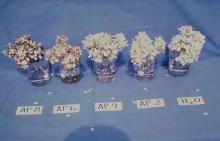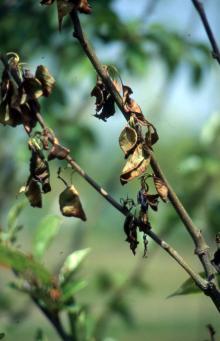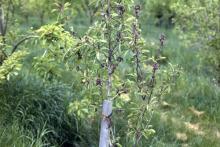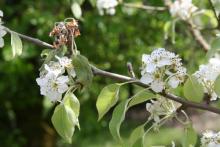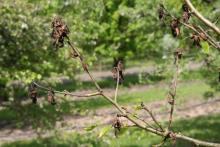Cause Pseudomonas syringae pv. syringae, a bacterium. Rain and low temperatures, especially frost-inducing temperatures during bloom, increase incidence of blossom infection. Although the bacteria survive on the outside of the plant they must get inside and multiply in the space between plant cells (apoplast) to cause disease. These pathogenic bacteria inject several proteins and small-molecule toxins to get past host immune mechanisms. Once inside, the bacteria induce a watery, nutrient rich environment between the plant cells where they can multiply and continue colonization of the plant tissues. Bacteria also produce a protein that acts as an ice nucleus, increasing frost wounds that bacteria easily colonize and expand.
Severe on wood: 'Old Home' and Asian pear cultivars.
Severe blossom blight: 'Packham's Triumph', 'Bartlett', 'Eldorado', 'Anjou', and 'Bosc'.
Less severe blossom blight: 'Comice', 'Forelle', red 'Anjou', and red 'Bartlett' cultivars.
Apple is not as susceptible and generally does not need control.
Symptoms Infection may cause blossom blast, leaf spots, dieback of twigs and spurs, dormant-bud death, and bark cankers. At first, bark cankers are light brown, irregular patches on limbs. Later, outer bark and some underlying tissues may wholly or partly slough away.
The blossom blast may closely resemble that of fire blight but is different in that necrotic tissue seldom extends more than 1 to 2 inches into the spur and never involves a bacterial exudate. The blossom blast also may resemble that caused by Botrytis. May also cause canker on young trees.
Cultural control
- Protect from frost using a variety of methods including overhead irrigation or wind machines.
- Prune Asian pear cultivars in summer.
- Remove and destroy infected tissue.
Chemical control Resistance to the active ingredients in these products has been detected in the Hood River, OR area.
- Badge X2 at 5.25 to 14 lb/A. Group M1 fungicide. 48-hr reentry. O
- Champ WG at 12 to 16 lb/A before fall rains and again before spring growth starts. Excessive dosages may russet fruit. Group M1 fungicide. 48-hr reentry.
- Cuprofix Ultra 40 Disperss at 7.5 to 10 lb/A. Group M1 fungicide 48-hr reentry.
- Kocide 50 DF at 8 to 12 lb/A before fall rains and again before spring growth starts. Excessive dosages may russet fruit. Group M1 fungicide 48-hr reentry.
- ManKocide at 12 to 16 lb/A before fall rains and again before spring growth starts. Excessive dosages may russet fruit. Group M1 + M3 fungicide. 48-hr reentry.
- Monterey Liqui-Cop at 3 to 4 Tbsp/gal water. H
- Nu-Cop 50 DF at 12 to 16 lb/A. Group M1 fungicide. 48-hr reentry. O
- Streptomycin (Group 25 fungicide) or oxytetracycline (Group 41 fungicide) applied at early bloom to control fire blight helps control Pseudomonas blossom blast. There are several registered trade names for products that contain streptomycin sulfate including Agri-Mycin and Harbour. 12-hr reentry. O
Reference Whitesides, S.K. and Spotts, R.A. 1991. Induction of pear blossom blast caused by Pseudomonas syringae. Plant Pathology 40:118-127.


